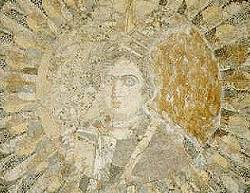The role of Alexandria in the Mediterranean
Scholars and Scholarly Thought
 The city, the foundation ceremony of which took place on 25th of the Egyptian month of Tybi (20th January), was intended, among other things, to be the connecting link between Alexander's kingdom in Macedonia and Greece which lay under his enforced hegemony, on the one hand and the eastern empire which he was in the process of acquiring at the time on the other. The final unity of the two regimes under his sway marked the turning point of a new era. The centre of what may be termed the historical gravity which had rested for a millennium in the Syrian plains and highlands, the battlefields of the contending eastern empires, had now shifted to the eastern part of the Mediterranean - the central point between East and West - thus presenting a suitable atmosphere for an active role for any city in the area that might have or acquire the attributes suited to the requirements of the age.
The city, the foundation ceremony of which took place on 25th of the Egyptian month of Tybi (20th January), was intended, among other things, to be the connecting link between Alexander's kingdom in Macedonia and Greece which lay under his enforced hegemony, on the one hand and the eastern empire which he was in the process of acquiring at the time on the other. The final unity of the two regimes under his sway marked the turning point of a new era. The centre of what may be termed the historical gravity which had rested for a millennium in the Syrian plains and highlands, the battlefields of the contending eastern empires, had now shifted to the eastern part of the Mediterranean - the central point between East and West - thus presenting a suitable atmosphere for an active role for any city in the area that might have or acquire the attributes suited to the requirements of the age.
 Nor did Alexander's premature death alter anything on this score. Rather than suffering a regression, the new shift was enhanced by the rise of the three main Hellenistic monarchies, the Antigonid, the Seleucid and the Ptolemaic, which flanked the Eastern Mediterranean on its three sides. During the protracted struggle among the new powers for supremacy in the area, the Ptolemies spared no effort from the very beginning of their rule, to turn Alexandria, which soon became their capital, into the first city and port in the Mediterranean in every respect and in every conceivable manner - thus provoking the atmosphere in which Alexandria would play its role in the history of the Mediterranean, not only at the time of the Ptolemies, but long after their ruling dynasty had disappeared.
Nor did Alexander's premature death alter anything on this score. Rather than suffering a regression, the new shift was enhanced by the rise of the three main Hellenistic monarchies, the Antigonid, the Seleucid and the Ptolemaic, which flanked the Eastern Mediterranean on its three sides. During the protracted struggle among the new powers for supremacy in the area, the Ptolemies spared no effort from the very beginning of their rule, to turn Alexandria, which soon became their capital, into the first city and port in the Mediterranean in every respect and in every conceivable manner - thus provoking the atmosphere in which Alexandria would play its role in the history of the Mediterranean, not only at the time of the Ptolemies, but long after their ruling dynasty had disappeared.
The aspects of this role, as might be expected, were many and various. At times they were greatly positive, at others Alexandria looked more like being involved in a role, but in all cases what took place was outstandingly, sometimes fatefully, singular. This brief survey can, of course, accommodate no more than the general outlines of some of these aspects.
Photos: (top) A piece of mosaic found at Tell Temai near Sinbelaween in 1918. (Graeco-Roman Museum, Alexandria) Interpretation I: A portrait of Queen Berenice II, wife of Ptolemy III "Eurgetes I", represented wearing military garbe, holding a sail and wearing a cap in the shape of a warship as a symbol of control over the Mediterranean Sea. Interpretation II: The the city of Alexandria represented in the shape of woman wearing a head-dress in the shape of a ship, symbolising the role of Alexandria in the Mediterranean. (bottom) Mosaic depicting a marine city, possibly Alexandria, personified as a woman. (Graeco-Roman Museum, Alexandria)